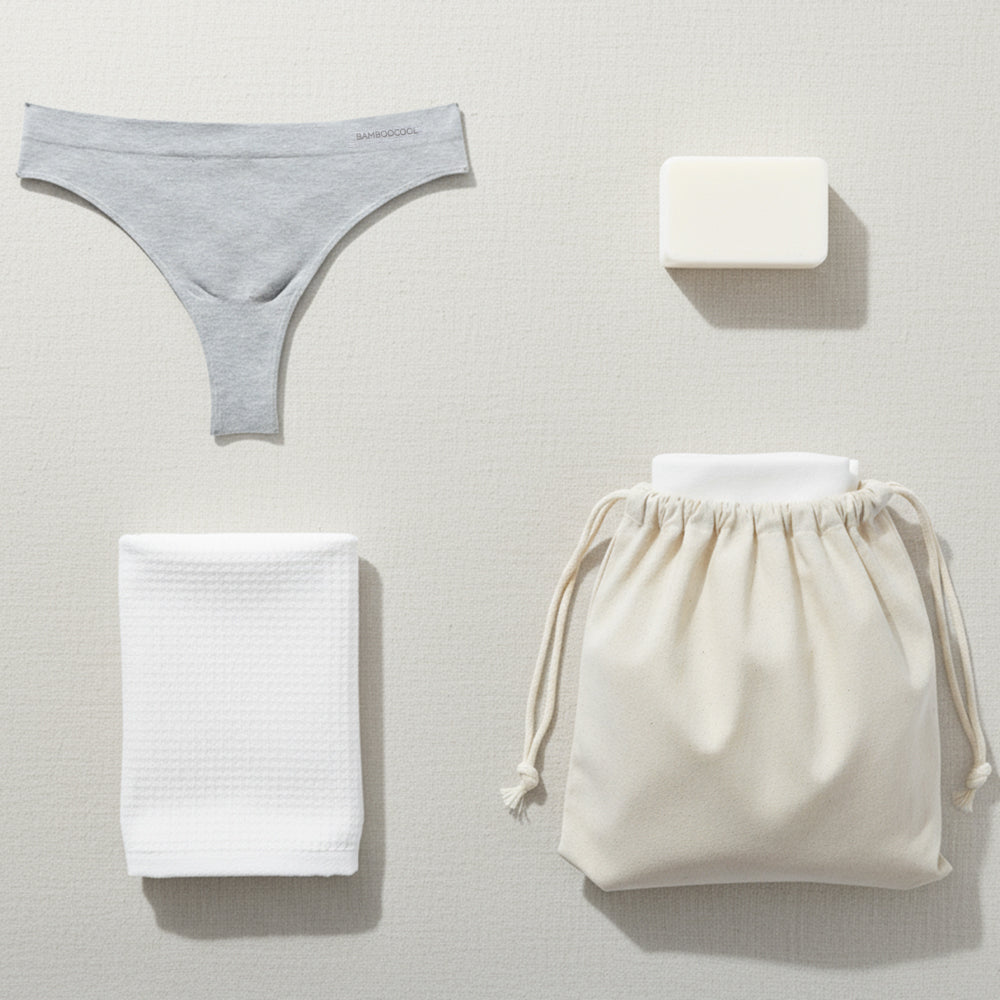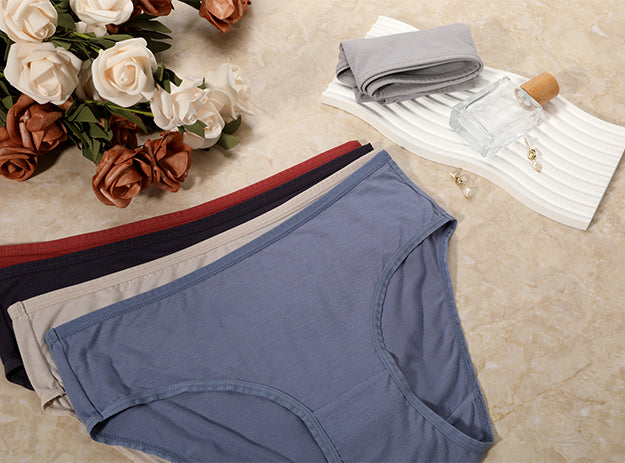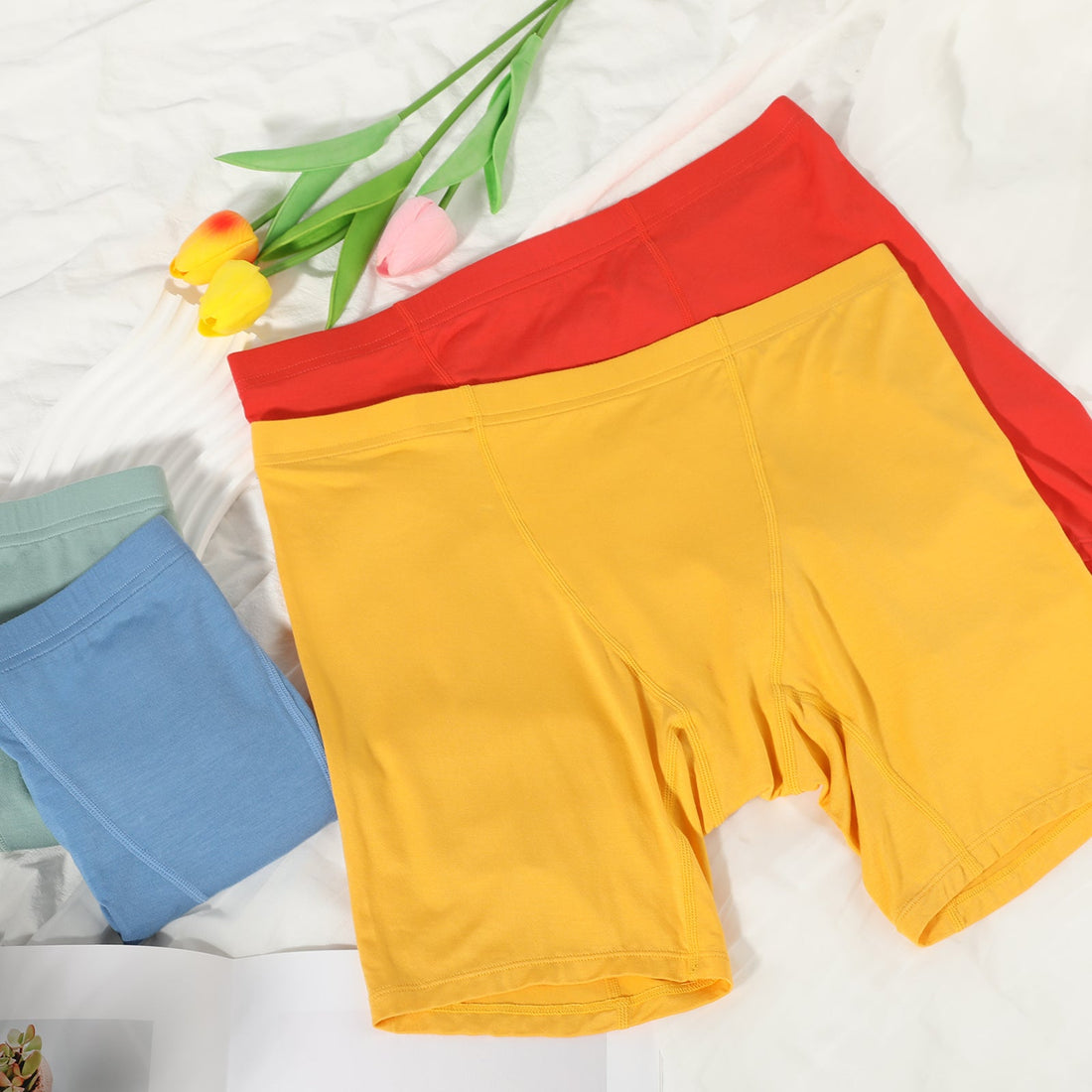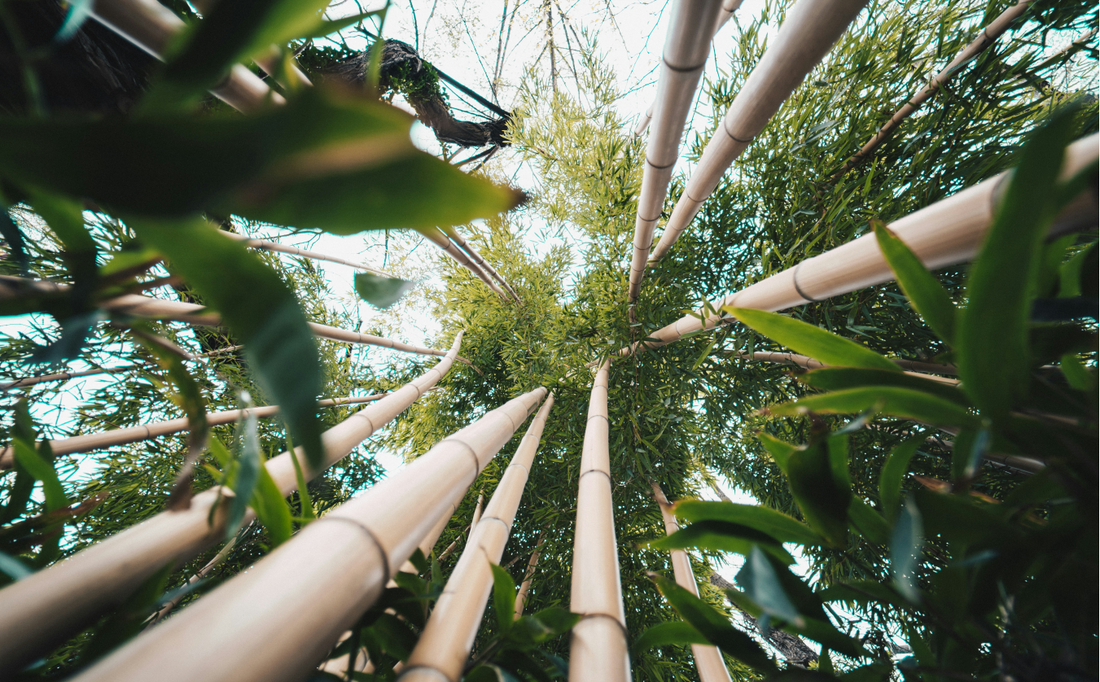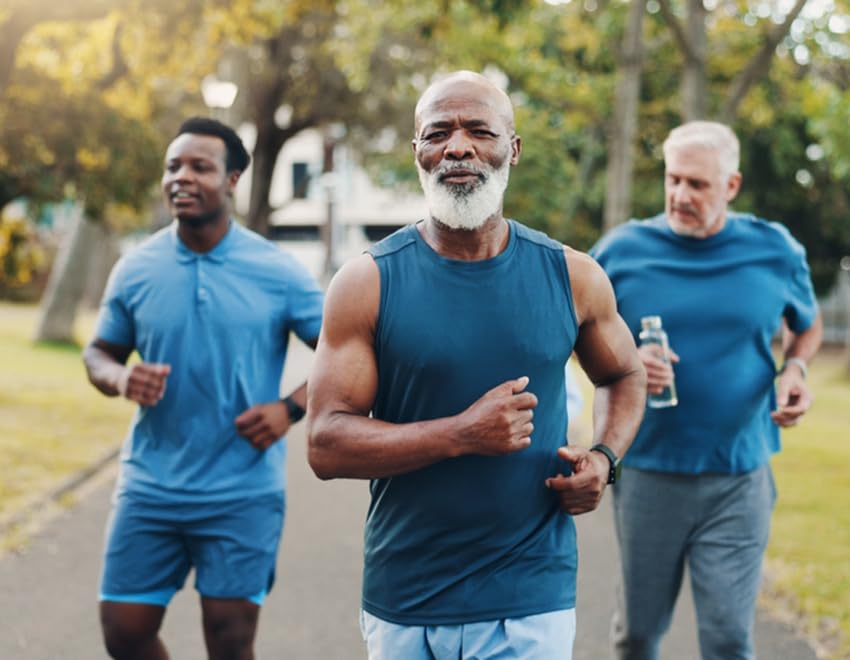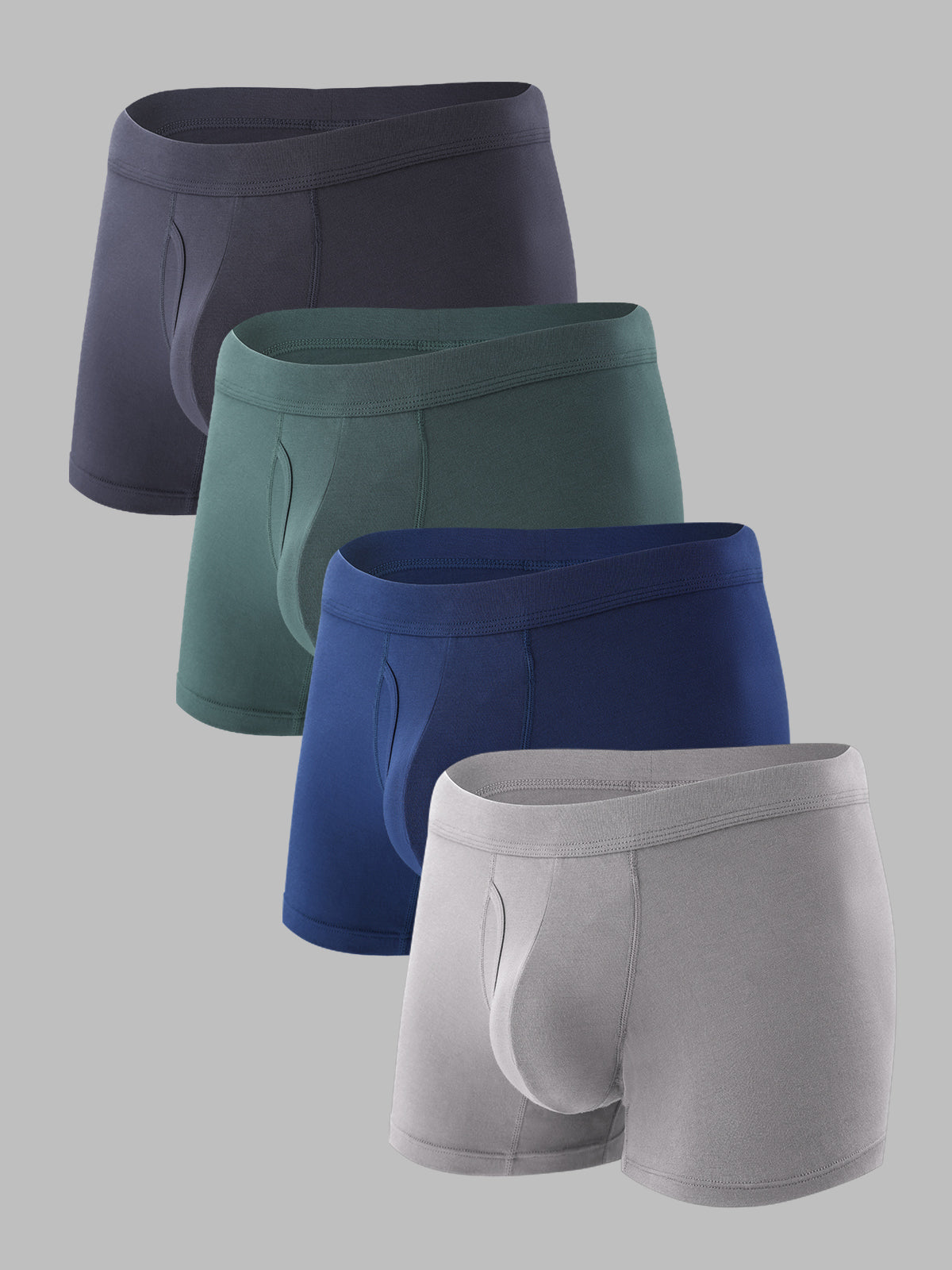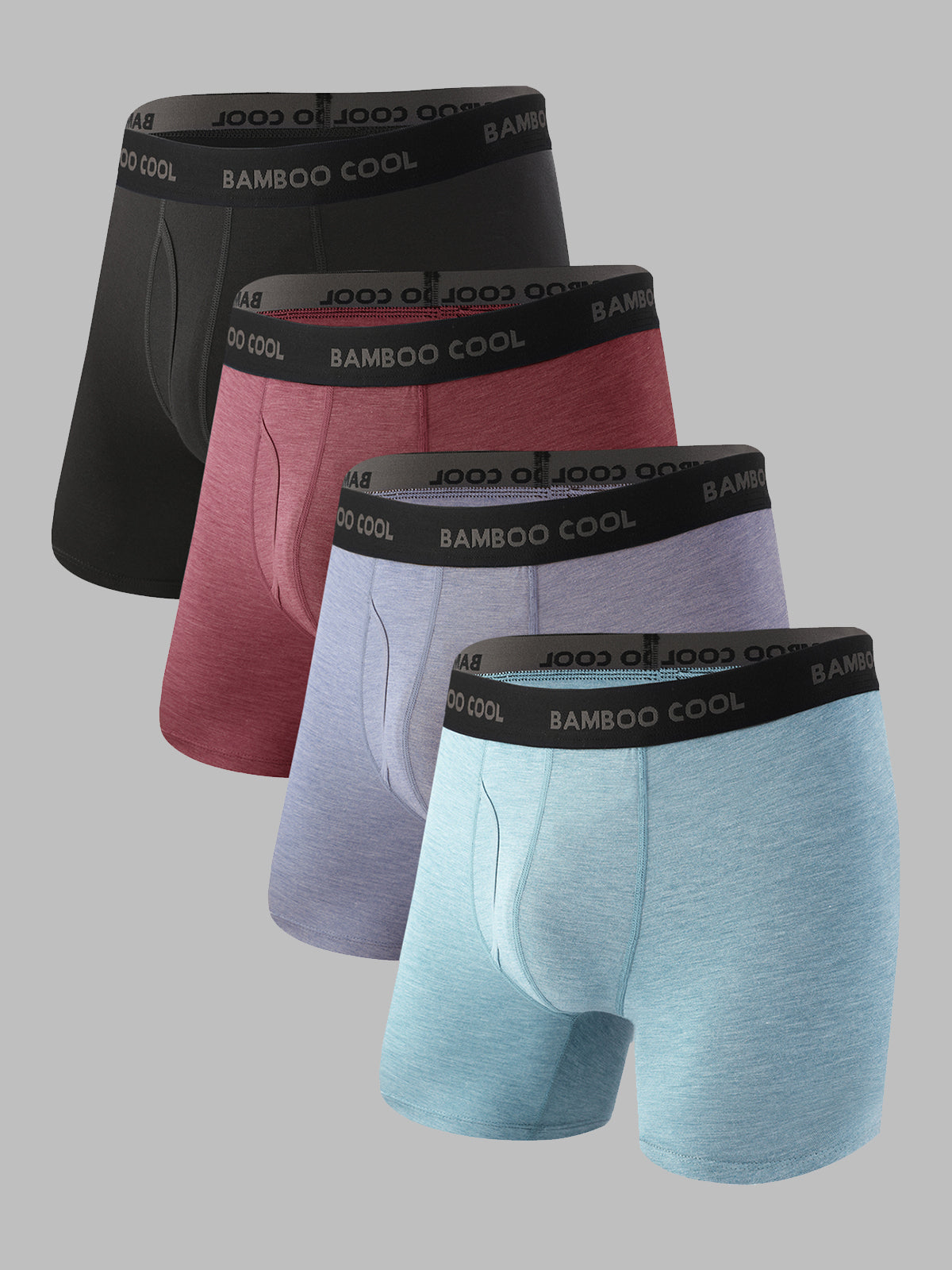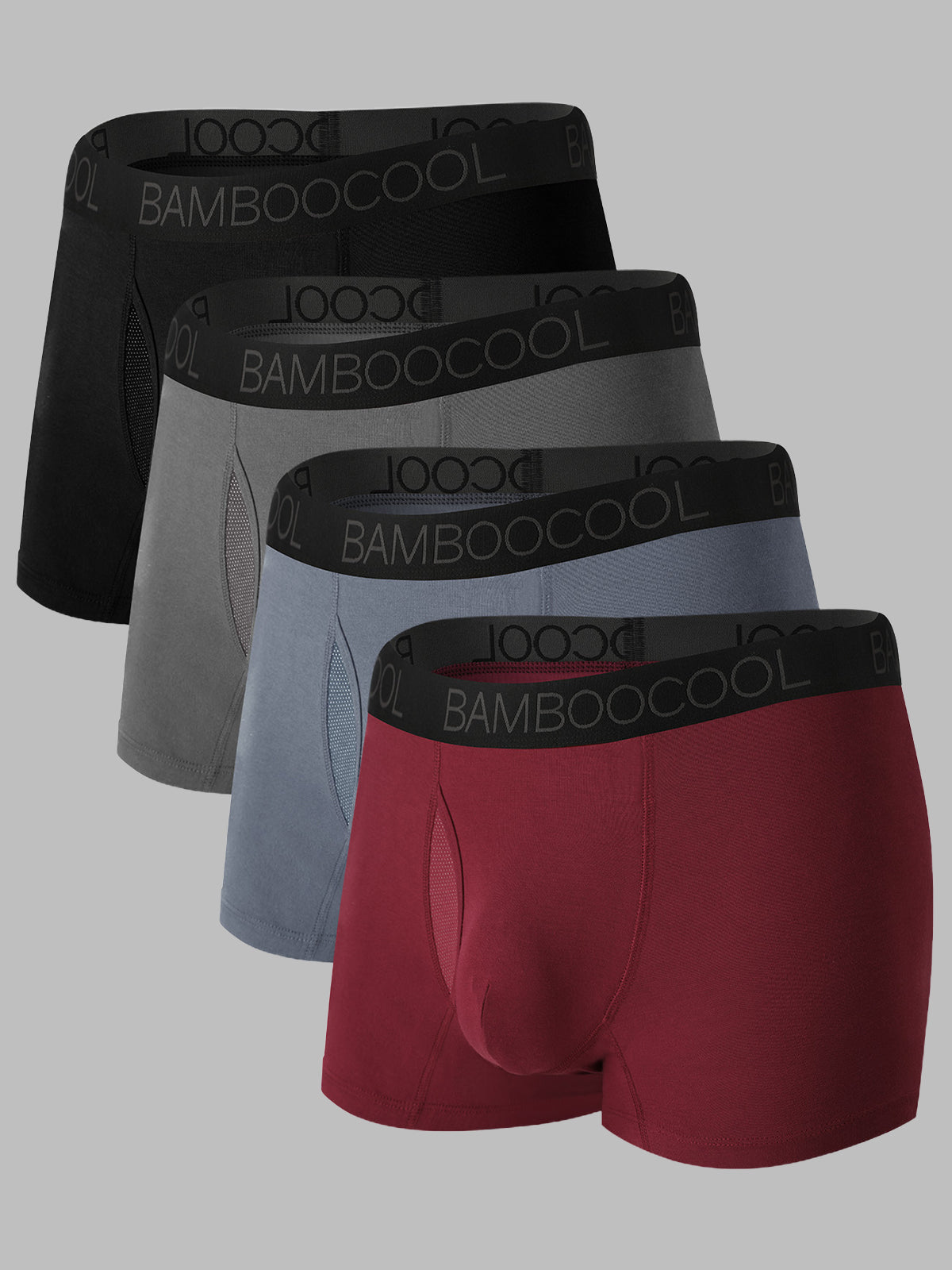NEWS
A Guide to Men's Underwear Sizing
The Right Fit Feels Different: A Guide to Men's Underwear Sizing You don't think much about your underwear—until it doesn't fit. But here's the tricky part: sizing isn't always straightforward. Between vague size labels and brand-to-brand differences, buying underwear can feel like a guessing game. That's where we come in. In this guide, we'll help you cut through the confusion. You'll learn how to measure yourself properly, understand what those size charts really mean, and choose the pair that fits your body (and your life) just right. Why the Right Underwear Size Really Matters Wearing the wrong size underwear is like squeezing into shoes that don't fit — uncomfortable, distracting, and just not worth it. Too tight? You'll get red marks, irritation, and way too much heat where you really don't want it. It can even mess with circulation and cause rashes or itching down there. Too loose? Constant shifting, zero support, and a whole lot of adjusting all day long. Not exactly confidence-boosting. The right size fits like a second skin — no digging in, no slipping around. It gives you comfort, support, and the confidence to move freely and feel good. So yeah, underwear size matters. A lot. Don't Guess-- Measure! Find Your True Size Buying underwear shouldn't be a guessing game. Since every brand has its own sizing guide, the smartest move is to know your own measurements—especially your waist and hips. Ready? Grab a soft measuring tape! 1. Measure Your Waist Stand up straight and breathe normally. Wrap a soft measuring tape around your natural waistline—this is usually the narrowest part of your torso. Make sure the tape is snug but not tight—you should be able to slide one finger under it. Note the number where the tape meets the starting point. For best accuracy, record the measurement in centimeters. 2. Measure Your Hips(Optional) Now for the hips! This one's just as important, especially for making sure your underwear stays in place and doesn't ride up or sag. Stand naturally, then wrap the tape around the fullest part of your hips. Keep the tape level and close to your body, without pulling it too tight. Where it meets the starting point is your hip measurement. Again, record this in centimeters. Note: If you don't have a soft measuring tape, use a string or ribbon to measure around your waist or hips, then lay it flat and use a ruler to find the length. 3. Match with a Size Chart Once you have your waist and hip numbers, compare them with the size chart provided by the underwear brand you're shopping from. Every brand is a little different, so this step is key. Tip: If you're between two sizes, size up for a looser, more relaxed fit. But if you like a snug, supported fit and the fabric has good stretch, sizing down may work too. Bamboo Cool Size Chart Thinking of trying BAMBOO COOL? Here's how your measurements line up with our size chart, so you can pick the perfect fit. BAMBOO COOL Men's Boxer Size Chart BAMBOO COOL Men's Brief Size Chart BAMBOO COOL Men's Boxer Brief Size Chart BAMBOO COOL Men's Trunk Size Chart Respect Your Shape: Let Your Body Be The Judge Everyone's body is different . The perfect pair isn't about just matching numbers on a chart — it's about how you feel when you wear them. Even if two people have the same measurements, their preferences for fit, tightness, and support can vary wildly. So remember: a size guide is just a reference — your comfort is the ultimate truth. Here's how to listen to your body and figure out if your underwear really fits: Waistband Woes A good waistband should stay put — not squeeze or sag. If you're seeing red marks, feeling pressure, or dealing with irritation, it's probably too tight. Try sizing up or look for softer, wider waistbands. If the waistband feels loose or keeps slipping down, go a size smaller for a snug, secure fit. Butt Fit Blues Your underwear should hug your butt, not fight it. It should stay in place, without riding up or drooping down. If it feels too tight, digs in, or the fabric rolls or wedges — it's too small. If it feels saggy, baggy, or constantly needs adjusting — it's probably too big. Leg Openings Trouble Don't ignore your thighs! If you've got strong legs, make sure the leg openings aren't too tight — this can cause chafing, restriction, and annoying ride-ups. Try a larger size or switch to a new style like briefs. Too much fabric or bunching around your thighs? Go for a smaller size or a slimmer fit. Pouch Problems Support matters — especially down there. The pouch should gently support, not squeeze or suffocate. If it's cramped or too tight, go up a size. If it's droopy, empty, or lacks support, go down a size for a better hold. Final Thought Your body is unique — and finding the right fit takes trial and error. Don't be afraid to try different sizes and styles. When trying a new brand, look for return or try-on-friendly policies, and always check reviews from people with a similar build to yours — they might save you from a bad fit! At BAMBOO COOL, our flexible fits and soft, breathable fabrics are made to flatter all body types. If your first pair doesn't fit quite right, just email info@bamboocoolapparel.com for an easy exchange or return. Find your perfect fit — Shop now
Learn moreUnderwear Buying Guide: Choose BAMBOOCOOL for Natural Comfort
🩲 Underwear Buying Guide: Choose BAMBOOCOOL for Natural Comfort 🌿 Underwear is a daily essential. Choosing the right pair not only affects comfort but also impacts your health and confidence.Among many brands, BAMBOOCOOL stands out with its natural bamboo fabric, ergonomic fit, and strong commitment to sustainability. Here’s a guide to the five key factors to consider when buying underwear, helping you make the right choice. ✅ 1️⃣ Fabric: Opt for Natural, Breathable Bamboo 🌱 The fabric of your underwear directly influences your wearing experience. BAMBOOCOOL uses natural bamboo viscose, which is highly breathable and moisture-wicking, keeping you dry and fresh throughout the day. Bamboo viscose fibers are naturally antibacterial, helping reduce skin irritation and allergies — perfect for all skin types. 🌸 2️⃣ Size: Measure Accurately for the Perfect Fit 📏 A proper size is essential for comfort. Use a soft measuring tape around the fullest part of your hips to get an accurate measurement. Refer to BAMBOOCOOL’s size chart to select your ideal fit. Wearing the right size prevents digging, slipping, or discomfort — ensuring all-day ease. 👌 3️⃣ Design: Focus on Cut and Support ✨ Underwear design should follow ergonomic principles, offering proper support. BAMBOOCOOL underwear features seamless construction to reduce friction and increase comfort. The elastic waistband ensures a secure, snug fit, making it ideal for everyday activities and exercise. 💪 4️⃣ Functionality: Choose Styles for Every Occasion 🎽 Different occasions require different underwear functionality. BAMBOOCOOL offers a variety of styles: Everyday wear, Active performance, Seamless/no-show options. Whether for work, workouts, or special occasions, picking the right style enhances your overall comfort and experience. 🌟 5️⃣ Sustainability: FSC-Certified for a Greener Future 🌏♻️ While comfort is essential, choosing a sustainable brand is equally important. BAMBOOCOOL is committed to environmental responsibility.All bamboo viscose are sourced from FSC (Forest Stewardship Council) certified sustainable forests, ensuring materials are eco-friendly, legal, and responsibly managed. FSC certification shows our dedication to protecting natural resources and promoting a greener planet. 🌿 By choosing BAMBOOCOOL, you care for yourself and the environment. 💚 ✅ Summary When buying underwear, consider: Fabric, Size, Design, Functionality, and Sustainability 🌱 BAMBOOCOOL combines: Natural bamboo viscose Ergonomic fit FSC-certified sustainable materials …to provide a comfortable, healthy, and eco-conscious wearing experience. Choose BAMBOOCOOL — enjoy daily comfort that respects your body and the planet. 🌏💚
Learn more🩲 How Often Should You Change Your Underwear?
The BAMBOOCOOL Guide to Everyday Comfort & Hygiene Underwear — it’s small, often overlooked, but plays a huge role in your daily comfort and hygiene.When should you replace it? How often should you wash it? And what kind of fabric truly keeps you feeling fresh all day? Let’s break it down with some clean facts and a breathable solution: BAMBOOCOOL bamboo underwear. 1. Should You Change Your Underwear Every Day? Yes, you absolutely should. Unlike bras or outerwear, underwear sits directly against your most delicate areas, collecting sweat, natural oils, and bacteria throughout the day. Wearing the same pair for too long can lead to irritation, odor, and even infections. Here are a few situations when you should change more than once a day: After working out or sweating During humid weather During your menstrual cycle or heavy discharge days 💡 BAMBOOCOOL Tip:Our bamboo underwear is 4.5x more breathable than cotton, helping your skin stay cool and dry — even on your most active days. 2. How Often Should You Wash Your Underwear? Ideally, after every wear. Because of its close contact with your skin, even a short use can leave sweat and bacteria in the fibers. Here’s how to care for your underwear the right way: Wash after each use Use mild or neutral detergent (avoid harsh chemicals) Hand wash or use a gentle machine cycle at 30–40°C (under 104 Air dry naturally — skip the dryer and direct sunlight to protect elasticity 💚 Why BAMBOOCOOL Makes It Easier:Bamboo viscose fibers are naturally antibacterial, meaning your underwear stays fresher longer and is easier to clean. The smooth texture also resists deformation and fading, even after many washes. 3. When Should You Replace Your Underwear? Even with great care, underwear doesn’t last forever.Watch for these signs that it’s time to say goodbye: Elastic waistbands feel loose or stretched out; Fabric is thinning, pilling, or fading; Lingering odor that doesn’t go away after washing; Visible tears, holes, or loose seams. ⏳ General rule: Replace every 3–6 months, depending on wear frequency and washing habits. 💡 BAMBOOCOOL Tip:Keep at least 7–10 pairs in rotation — it helps every pair last longer and keeps your weekly routine clean and easy. 4. Why Choose Bamboo Underwear? Not all underwear is made equal. Cotton and synthetic fabrics often trap heat and moisture, while BAMBOOCOOL bamboo viscose fiber keeps things fresh and breathable all day. Here’s why our customers make the switch: 🌿 4.5x More Breathable Than Cotton The microscopic structure of bamboo viscose fibers allows better airflow and moisture evaporation. 🩵 Naturally Antibacterial & Odor ResistantBamboo contains a bio-agent called Bamboo Kun that helps prevent bacterial growth and keeps you smelling clean. ✨ Soft, Smooth & HypoallergenicFeels like silk against your skin — perfect for sensitive areas. ♻️ Eco-Friendly & BiodegradableMade from sustainable bamboo forests, free of harmful dyes and microplastics. Soft on your skin, gentle on the planet. Whether you’re heading to the gym, lounging at home, or getting through a busy day at work, BAMBOOCOOL bamboo underwear gives you a breathable comfort you can feel. 5. Quick Takeaways ✅ Change your underwear daily✅ Wash after every wear using gentle care✅ Replace every 3–6 months or when signs of wear appear✅ Choose bamboo viscose fiber for better breathability and hygiene✅ Rotate pairs to extend lifespan Because true comfort starts with what’s closest to your skin.Let your body breathe, stay confident, and live comfortably — every single day. 💚 BAMBOOCOOL — Comfort That Breathes Naturally.Explore our full bamboo underwear collection → https://bamboocoolapparel.com/
Learn moreWhat Is Bamboo Viscose Fabric?
What Is Bamboo viscose Fabric? Discover the Future of Sustainable Comfort When it comes to sustainable fabrics, Bamboo viscose Fabric is one of the most innovative and versatile materials. Made from fast-growing, renewable bamboo, this fabric is soft, breathable, and durable — making it a rising star in fashion and textiles. What Is Bamboo viscose Fabric? Bamboo viscose Fabric is a natural textile made from the pulp of bamboo plants. Unlike synthetic fabrics, it comes from one of the most renewable resources on Earth. Grows quickly without chemical fertilizers or pesticides Pure, natural, and eco-friendly Produces a fabric that is luxuriously soft and functional This makes Bamboo viscose Fabric ideal for underwear, t-shirts, and activewear that touch your skin every day. Key Benefits of Bamboo Viscose Fabric 1. Ultra-Soft & Gentle on Skin Silky smooth and comparable to premium fabrics. Perfect for sensitive skin thanks to its natural, gentle touch. 2. Highly Breathable & Moisture-Wicking Helps regulate body temperature. Keeps you cool, fresh, and dry throughout the day. 3. Year-Round Comfort Naturally adapts to seasons: Cool in summer ☀️ Warm in winter ❄️ 4. Sustainable & Eco-Friendly One of the fastest-growing plants in the world Regenerates naturally without replanting Requires minimal resources to thrive Choosing Bamboo Viscose Fabric supports a healthier planet compared to resource-heavy fabrics like conventional cotton. 5. Naturally Healthy Choice A safe and comfortable option for daily wear, offering peace of mind for anyone looking for a skin-friendly fabric. Why Bamboo Viscose Fabric Matters Today, consumers demand comfort + sustainability. Bamboo viscose Fabric provides both:✔ Eco-responsibility✔ High-quality performance✔ A shift toward better choices for people and the planet Bamboo Cool: Comfort Meets Sustainability At Bamboo Cool, we believe in creating underwear that cares for you and the environment. Eco Commitment: Bamboo Viscose Fabric is renewable, biodegradable, and lowers environmental impact. User Experience First: Every pair is designed for softness, breathability, and durability. For Everyone: Gentle on skin, making it perfect for sensitive skin and everyday wear. 👉 With Bamboo Cool, you’re not just buying underwear — you’re choosing a more sustainable lifestyle. Conclusion Bamboo Viscose Fabric is more than just fabric — it’s a lifestyle choice. It offers: Comfort 🌿 Sustainability 🌎 Skin-friendly care 🤍 With Bamboo Cool bamboo underwear, you’ll enjoy soft, breathable, and eco-friendly comfort every day — while making a positive impact on the planet.
Learn moreBAMBOO COOL Breakdown: Men's Boxer Briefs vs. Trunks
"Boxers or briefs?" – For decades, this was the only question in men's underwear debates. It was all about extremes—loose vs. tight, freedom vs. support. Then came Boxer Briefs — the genius hybrid that gave guys the best of both worlds: support where it counts, breathability where it matters. We actually covered that iconic three-way showdown not long ago. But just when you thought the battle was settled… meet trunks. At first glance, they might look like boxer briefs' slightly shorter cousin. And yes, those few inches of missing fabric? They do make a difference. So if you've ever wondered which one actually fits your body and your lifestyle better—this guide is for you. Boxer Briefs vs. Trunks: What's The Difference? At first glance, they might seem like twins—but Boxer Briefs and Trunks have some key differences hiding in plain sight. One's got longer legs, the other's all about that square-cut fit. They may both be fan favorites, but understanding what truly sets them apart is the first step to finding your perfect pair. What Are Boxer Briefs? Trunks are the shorter, modern version of boxer briefs. With a square-cut design and a higher leg, they offer a sleek, modern look while still providing same solid support. If you like the feel of boxer briefs but want something a little breezier and more fashion-forward, trunks might be your great pick. (BAMBOO COOL Men's Bamboo Viscose Boxer Brief) Length | Mid-thigh or longerFit | Snug but non-restrictiveSupport | High level of supportBenefits | Excellent support, full coverage, chafe preventionBest for | All body types, extra coverage and support, active movement What Are Trunks? (BAMBOO COOL Men's Bamboo Viscose Trunk) Length | Upper thighFit | Same snug fit, but shorterSupport | Excellent supportBenefits | Excellent support, less coverage, modern lookBest for | All body types, unrestricted freedom What Are The Differences? Let's get one thing straight—both boxer briefs and trunks offer top-tier support. That's not the debate. What really separates these two styles is leg coverage. Boxer briefs feature longer legs (mid-thigh or beyond). This extra length means less friction, less ride-up, and more protection—especially during intense workouts or long days on your feet. They're a top pick if you've got bigger thighs, prefer a bit more coverage to prevent chafing. On the flip side, the shorter cut (upper thigh) of trunks means more freedom of movement, better breathability, and a lighter feel overall. Perfect for warmer weather or guys who run hot. Boxer briefs shine under most outfits, even slim-fit pants. But in shorts or tighter trousers, they can feel a bit bulky. That’s where trunks win—they stay hidden, don’t peek out from under shorts. Got shorter legs or a leaner build? Trunks sit higher on the thigh, making legs look longer and showing off muscle lines. Meanwhile, if you've got more muscular thighs or live an active lifestyle, boxer briefs are a solid choice for stay-put comfort. Boxer Brief vs. Trunk - Which Is Right for You? Let's be real—both boxer briefs and trunks are great everyday options. They're supportive, versatile, and comfortable enough for most guys and most situations. But when it comes to choosing your ideal fit, it all comes down to personal preference—and the little details that make a big difference. From workouts to wardrobe, weather to body type, here's what to consider when picking the style that works best for you. For Sports & Workouts If you're an active guy, good news—both boxer briefs and trunks can handle your moves. But the right choice depends on what your body needs and how you like to move. With mid-thigh or longer legs, boxer briefs deliver full coverage and lockdown support—ideal for preventing chafing during high-impact or long-duration workouts. A must-have for muscular thighs or anyone craving extra protection. Trunks are shorter, lighter, and more breathable. Perfect for freedom of movement and pairing with athletic shorts—no awkward peek-outs here. What to Wear Them With Both boxer briefs and trunks offer a close fit, making them great under most pants. But if you're rocking slim-fit jeans or tailored trousers and want to keep a sleek silhouette, trunks are the way to go—they're shorter, use less fabric, and stay invisible under tighter styles. Wearing shorts? Trunks save you from that awkward moment when your underwear peeks out from underneath. Check the Weather (BAMBOO COOL Men's Breathable Bamboo Filament Mesh Boxer Brief) Boxer briefs and trunks both get the job done year-round—but when the temperature shifts, one might just edge out the other. In colder weather, boxer briefs offer a bit more coverage and warmth, thanks to their longer legs and fuller fabric. But when the heat is on? Less is more. Trunks, with their shorter cut and minimal material, keep things breezy and cool. No matter the season, fabric makes all the difference. Go for moisture-wicking, breathable materials like our signature bamboo viscose —it keeps you fresh, dry, and comfortable in any climate. Body Type Your build plays a big role in how your underwear fits—and feels. Boxer briefs extend past the widest part of the thigh, making them a solid choice for taller guys, those with thicker legs, or anyone with a broader build. The extra length offers more support and coverage where it counts. Trunks, on the other hand, hit just above that wide spot on the thigh. That makes them ideal for shorter frames or slimmer legs. They highlight muscle definition and leave a bit more room to move. The Verdict In the great underwear showdown between boxer briefs and trunks, there's no clear winner—only the right fit for you. Whether you prioritize support, coverage, or freedom of movement, the best choice depends on your body type, activity level, and personal comfort. Why Choose? Just Mix & Match! At BAMBOO COOL, we craft every pair from FSC-certified bamboo fabric—breathable, eco-friendly, and designed for real-life movement. Still unsure? No sweat: Contact our team—we'll help you swap styles or process a refund. Find Your Fit Now.
Learn moreBamboo, Panda, and Sustainability: Why Choose Moso Bamboo
When most people think of bamboo, they imagine pandas munching on green stalks in the forest. But did you know there are over 1,400 species of bamboo worldwide—and not all of them are panda food? In fact, the species of bamboo chosen for Bamboo Cool underwear is completely different from the bamboo that giant pandas eat. The Diversity of Bamboo Bamboo is one of the fastest-growing and most versatile plants on earth. Among its many species, the most commonly seen are: Moso bamboo Arrow bamboo Sinocalamus affinis Each type has unique properties and uses. Why Moso Bamboo Stands Out Among all bamboo species, Moso bamboo is the most widely used. Its tall, thick, and sturdy stems are so strong that in Southeast Asia, they’ve long been used in construction—earning the nickname “natural green steel”. But beyond construction, Moso bamboo has another hidden superpower: its fiber content. With about 40–50% usable fiber, Moso bamboo has one of the highest yields for textile production. This makes it the perfect raw material for Bamboo Cool’s breathable underwear. Sustainable and RenewableMoso bamboo isn’t just strong—it’s sustainable. Unlike trees that take decades to mature, bamboo reaches maturity in just 3–5 years and regenerates quickly after being harvested. That means bamboo can be continuously replenished without damaging the environment. By choosing bamboo over conventional materials, Bamboo Cool underwear supports a greener, more eco-friendly lifestyle. Comfort Meets Performance Thanks to the natural properties of bamboo fibers, fabrics made from them are: 1. Breathable – 6x more breathable than cotton, keeping you cool and fresh. 2. Moisture-absorbing – Quickly wicks away sweat for all-day comfort. 3. Soft and hypoallergenic – Gentle on sensitive skin. This combination makes Bamboo Cool underwear not just sustainable, but also a superior choice for everyday wear. https://bamboocoolapparel.com/collections/new-arrivals But Wait—Do Pandas Eat Moso Bamboo? Here’s the key question many people ask: If Bamboocool uses Moso bamboo, does that mean pandas are going hungry? The answer is no. Pandas mainly eat arrow bamboo, which is much shorter (2–4 meters tall) and far more tender than towering Moso bamboo (which can grow 15–20 meters tall). Pandas especially love fresh bamboo leaves and shoots, which are nutritious and easy to digest. In spring, they enjoy tender shoots. In autumn, they switch to leaves. Only in the depths of winter do they nibble on tougher stalks. And today, many pandas are raised in well-managed reserves and zoos, ensuring their diet is always secure. So rest assured—wearing Bamboo Cool underwear doesn’t take food away from pandas. The Final Takeaway Bamboo is one of nature’s most extraordinary resources—fast-growing, renewable, and multifunctional. By choosing Bamboo Cool’s breathable underwear made from Moso bamboo, you’re not only treating yourself to comfort and softness, but also supporting a sustainable future. And don’t worry—panda babies will never go hungry!
Learn more

